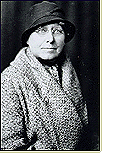|
|
|
| ||
|
1874-1847
Born seven years after Frances, Margaret gave up her school teaching career in 1912 to become her sister's full-time household manager and traveling companion. Like Frances, Margaret never married. The sisters were the only children in their family - an older brother died in infancy.1 Margaret was Frances' public liaison with whites and Indians. She was active in Red Wing church and women's' clubs and was generally described as the cheerful, friendly accompanist to her older sister's serious, businesslike manner.2 Frances often told her supervisors in Washington about Margaret's contributions: I…have this wonderful sister who can manage Indians "like a book" and on whom I depend in all important decisions. She has never done any of the actual work but is my "observer" and nothing ever gets by her. The balance of our partnership is remarkable. She was drawing the highest salary in her grade in the Minneapolis Public Schools when she gave up everything to forward my work and has been my constant companion in the field.On the reservations, Frances counted on Margaret for "protection" from Indians that might interrupt the recording work, and as a judge of Indian character. Margaret drove their Chevrolet and tended to living arrangements. In Red Wing, Margaret kept house and, according to Frances, was the only one in town capable of understanding the significance of the Indian work.3 Margaret died of heart failure on 25 January 1947, at the age of 73. She had supported Frances' research for more than 40 years. Frances suffered the loss heavily. At age 80, her lifelong companion was suddenly gone. To save money and escape the burden of housework, Frances sold the family home in Red Wing and moved to a rooming house up the street. Frances lived alone until her death ten years later. Frances and Margaret are buried side-by-side in an oak-shrouded cemetery on a bluff above Red Wing.
| ||||

